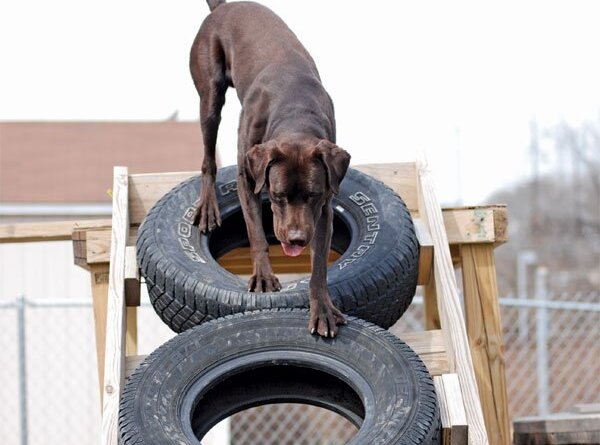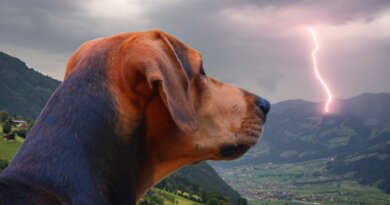Training Working Dogs | The Bark
A unique program at the University of Pennsylvania School of Veterinary Medicine—the Penn Vet Working Dog Center—not only trains detection dogs from puppyhood, but also, studies every aspect of their development in order to determine how to identify and train the finest detection dogs possible, dogs whose work is critical when natural and human-caused disasters hit. The center officially opened on September 11, 2012, at a former DuPont facility just south of the main campus. All of the puppies are named after dogs who served at Ground Zero and elsewhere in the wake of the 9/11 terrorist attacks.
“We want to focus on what the nose can do,” says the center’s founder and director, Cynthia Otto, associate professor of critical care at Penn’s School of Veterinary Medicine. Otto, who had been providing medical care to detection dogs for FEMA since 1994, joined a contingent of first-responders from Pennsylvania at Ground Zero in September 2001. Initially, the dogs were deployed to search for survivors, but ended up locating the remains of victims.
After the disaster, Otto and some of her colleagues in the working-dog world took a serious look at the factors that come into play in the best detection dogs. Was it genetics? Or could a dog’s natural talents be optimized? Was it possible to identify successful detection dog candidates from shelters or rescues? If so, how? Otto, a scientist, began planning a program that would provide answers.
Otto decided to break with the practice of most detection-dog programs—including those of the military and many law enforcement agencies—which wait until dogs are a year old before beginning their detection training. Instead, she wanted to give puppies an overall “liberal arts” experience that included obedience, agility, searching, direction and control, drive building, impulse control, socialization, play, fitness, and husbandry. Then, she would study their development during that crucial first year, gather evidence of what worked and what didn’t, and use that information to guide the development (and identification) of even better detection dogs.
GET THE BARK NEWSLETTER IN YOUR INBOX!
Sign up and get the answers to your questions.
Another unusual feature of the center is that, rather than being kenneled, the dogs live in foster homes. Such a system requires a great deal of organization; after several years of fund-raising and searching for a location, Otto hired three full-time employees to manage operations, direct the dogs’ training and coordinate the many volunteers who would be required. Then, she and her staff set about finding puppies whose pedigrees indicated that they had the drive and temperament to become exemplary detection dogs.
Good Timing
Ronnie, a black sable German Shepherd, is one of the dogs who spent his first year at the new Penn Vet Working Dog Center. As a puppy, he was fostered by Cathy Von Elm and lived with her and Auggie, Von Elm’s Cardigan Welsh Corgi, in their Center City Philadelphia home. Evenings and weekends were spent doing typical puppy things: playing with Auggie, tossing giant fleece bones in the air, filching ice from Von Elm’s glass, going to the country on weekends. Every weekday morning, however, on her way to work, Von Elm dropped Ronnie off at “school”—the Penn Vet center; in the evening, on her way home, she picked him up.
Ronnie came from breeder Julie Stade, whom Otto had met in 2012 at a national breeders’ conference, where Otto was giving a seminar. Stade, who’s based in Kansas and is known for her work with Doberman Pinschers, had recently made a foray into breeding German Shepherds and was awaiting her first litter. The parents came from impressive lines of Czech dogs, and Stade was interested in donating one of the puppies to the center.
Her timing was excellent: Otto was looking for just the right German Shepherd to add to her class of puppies. She wanted a namesake for another Ronnie—a Czech German Shepherd whose handler, David Lee, had been a longtime detection-work colleague before his retirement from the Philadelphia police force. (Lee had introduced Otto to Annemarie DeAngelo, a retired New Jersey State Trooper and founder of their canine program, who became the center’s director of training.)
In November 2012, Stade’s dog Burana whelped; Ronnie was the fifth of nine males. As she does with every new litter, Stade conducted what she calls “the matching game”: figuring out which dog is best suited for a prospective owner. “It’s my favorite part of the process,” she says. Stade observes the puppies’ behavior from birth and presents them with challenges, such as a variety of loud noises, to see how they respond—who gives up, who perseveres, who looks to a human to solve the problem, who whines.
After she’d narrowed down the choice to three dogs, Stade and her husband took Burana and the puppies to a park that was a two-and-a-half-hour drive from their farm, an adventure they hoped would help her make the final decision. “I had the brilliant idea of putting them in the back of a horse trailer,” she says ruefully.
Stade rode in the back with the dogs and all of their equipment, but she quickly discovered that without a horse’s weight, the trailer and everything inside bounced. “It was a far more extreme test than I ever would have done intentionally. I never want to put puppies in a situation where they question or doubt themselves.”
Ronnie, still unnamed, was identified only by his yellow collar. While his red-collared and blue-collared brothers reacted to the sounds and movement by becoming angry or anxious, Ronnie took in his surroundings and then promptly curled up and drifted off to sleep. Ronnie wasn’t just an intrepid traveler—he seemed to be unflappable.
In late January 2013, the time came for Ronnie to leave Stade’s farm for his life in Philadelphia. By then, however, the cold weather made it risky to ship him in a plane’s cargo hold. The center needed a volunteer to carry Ronnie on the flight. But there was another complication: Stade likes to keep her puppies well fed just before placement so they have some extra padding to help them adjust to the stress of their new surroundings.
“Ronnie was really fat,” she confesses. In fact, he was eight weeks old and weighed 29 pounds. Would he even fit under the seat of a plane? There was only one solution. David Lee, now a contractor for the Department of Homeland Security, was unlikely to be challenged if there were difficulties during the flight. He volunteered to fly to Kansas and bring Ronnie to Philadelphia.
Lee recalled seeing the Buddha-shaped Ronnie for the first time: “He was bright-eyed and bushy-tailed … just a ball of fire.” While playing tug with Ronnie, Lee instantly fell for his charms, but wondered what he’d be like on the plane. Lee had yet to discover that Ronnie didn’t just resemble Buddha—he possessed his enlightened detachment, too. On the flight, Ronnie didn’t flinch, whine or bark. He just sat on Lee’s lap. When Lee put Ronnie on the adjacent seat, he looked around, lay down and slept.
After arriving in Philadelphia, Lee was able to spend some time with Ronnie. He took him everywhere—to a warehouse, to the beach, down stairs. “Nothing fazed him,” Lee remembers. “He was a great dog even then.”
Trained for Excellence
School is a full-time affair at the Working Dog Center. After being dropped off each weekday morning before 9 am, the puppies spend the day at the center until their foster families pick them up sometime between 5 and 7 pm. The dogs are trained on-site, and their daily training regimens are tracked on a master board. All areas must be covered in a predetermined rotation, but obedience training takes place every day, if only while the dogs are being taken outdoors.
In addition to several indoor training areas, the center has a dedicated outdoor agility course and a rubble pile. They use a nearby vacant warehouse for search training. Regular field trips expose the dogs to as many different environments as possible. Destinations include local warehouses, airport terminals, the Philadelphia subways and the rubble pile, which is in New Jersey.
Dogs are grouped according to age so those with a similar skill level can go through a particular training scenario together, but they’re never held back because of their age. Each dog has to master basic scenarios before moving on to those that are more complex. Depending on how many staff members are available, the dogs go through two or three scenarios per day.
Search training, part of which involves finding a volunteer in an empty barrel on the agility course, is probably the most fun to watch—it’s like a really elaborate game of hide-and-seek. Or, one of the puppies might be let loose inside the empty warehouse to find a tug toy. The reward in either case is a well-earned game of tug and a wagging tail. “It’s a game, making it fun for them,” says Training Director DeAngelo.
Regardless of the setup, logistics matter. The dogs need to be transported to training destinations in crates, but the center’s cargo van cannot carry them all, so staff vehicles usually join the caravan. Each puppy also needs his or her own handler during training. Many of the handlers are volunteers or interns, and every attempt is made to pair a dog with the same handler as often as possible. In addition to the director of training, the center has two full-time and three part-time trainers. The part-time trainers have dedicated areas of expertise: agility, obedience and reactivity. When they’re not training, the dogs rest in their crates or are taken for walks, often to Penn’s main campus, where they play and socialize with students.
Otto estimates the costs of raising and training each dog to be $36,000. Penn’s vet school provides their health care, and various companies donate food and other supplies (foster families incur no expenses). In Ronnie’s case, the Wawa convenience store chain made a donation to the center to support his care. Such contributions are crucial, as the center depends entirely on donations for its operating budget.
Job Assignment
Perhaps the most challenging fields for a detection dog are law enforcement and search and rescue (SAR). A major difference is that there are periods of inactivity in SAR work, but law-enforcement dogs work almost daily. “Ronnie can do anything,” declares Otto, and that seems to be the consensus of opinion among those who’ve come in contact with him. “He’s an awesome work dog,” says DeAngelo. David Lee goes further: “I’d love to be his handler. He’s the most laid-back dog I have ever worked with. The only thing that I would fear is if he did something that bored him. As long as it’s fun, that dog will work for days. He’s just that good.”
Initially, Otto was hesitant about placing the center’s dogs in law enforcement because that would require training them in bite work, a key component of criminal apprehension. Introducing an aggressive behavior has to be done carefully to avoid having it affect the dog’s personality. Nevertheless, when the police department of Philadelphia’s mass transit authority, known as SEPTA, announced that it was expanding its canine unit, Otto carefully considered the opportunity.
Ronnie had the chance to prove himself at SEPTA’s 2013 Iron Dog Challenge, an annual fundraiser in which teams of working dogs and their handlers compete in a specially designed course of more than 25 challenges, which include having the dog jump through a window, demonstrate nonreactivity to a gun shot, be carried uphill and placed over a barrier, complete a low crawl, and criminal apprehension. For Ronnie to compete, he had to be trained to bite on command.
Fortunately, one of the center’s volunteers is Bob Dougherty, a certified law enforcement canine trainer who is also a member of the Cheltenham, Penn., police K9 unit. Dougherty worked with Ronnie over several months of accelerated training that included more directed searching and tracking and the subtle work of teaching the bite-on-command behavior.
According to Dougherty, the key is to manage stress so that the dog never feels a pressure to perform, and training remains a game. Dougherty’s goal is to find a balance between achieving results from the dog and maintaining the dog’s happiness, so that the next time, the dog is even more eager to practice biting. “Ronnie is such an easy dog to work with,” says Dougherty. “All the foundation work was done so well. It wasn’t difficult at all.”
Although Ronnie didn’t place at the Iron Dog competition, he did well enough against the more than two dozen teams of certified working dogs and handlers that SEPTA officials took notice. Since 2005, SEPTA had been rescuing dogs from shelters and training them to be canine officers. In January 2014, Ronnie and one of his classmates became the first dogs SEPTA purchased. With the help of a grant from the Department of Homeland Security, the group paid $8,000 for him.
Ronnie now lives with his handler, Officer Javier Class. Class is new to the canine unit, but has been around dogs all his life and always knew he wanted a canine partner. Nevertheless, when he met Ronnie, he was taken aback by the Shepherd’s size. Ronnie weighs100 pounds, and Class says it occurred to him that he might not be able to handle the dog. Class’s moment of doubt quickly disappeared as he and Ronnie bonded.
The two fulfill the principle of opposites attracting: whereas Class has plenty of patience, Ronnie is so eager to work that SEPTA’s head trainer, Officer Dave Parke, has instituted what he calls the “30-second rule”: he has to explain every new concept in 30 seconds so that Ronnie can get to work. Otherwise, the dog barks impatiently. When Ronnie is home with Class, his wife and two children, however, he’s a different dog. Class attributes this to the home environment that Von Elm and Auggie gave Ronnie in his first year.
Ronnie will almost certainly spend the rest of his life with Class and his family, even after he grows too old for active duty (something that’s difficult to imagine today). Barring injury or illness, Ronnie will work until he’s nine or 10, which is about the point at which dogs begin to lose their stamina for the rigors of scent work. For now, Ronnie’s most definitely on the job, and when he’s not, he spends a lot of time with his new best friend, Class’s six-year-old daughter. Their favorite game? Hide-and-seek, of course.




